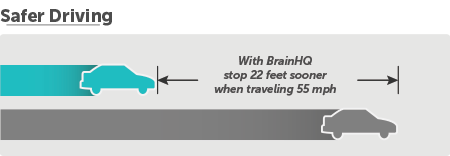Information and citations for studies on BrainHQ assessment on training and driving
“Cognitive training decreases motor vehicle collision involvement of older drivers”Published in: Journal of the American Geriatrics Society
Lead Author: Karlene Ball, PhD, University of Alabama at Birmingham
View article
“The longitudinal impact of cognitive speed of processing training on driving mobility”
Published in: The Gerontologist
Lead Author: Jerri D. Edwards, PhD, University of South Florida
View article
“Cognitive speed of processing training delays driving cessation”
Published in: Journal of Gerontology, Series A
Lead Author: Jerri D. Edwards, PhD, University of South Florida
View article
“Speed-of-processing and driving simulator training result in improved driving performance”
Published in: Human Factors
Lead Author: Daniel L. Roenker, PhD, Western Kentucky University
View abstract
“Visual attention problems as a predictor of vehicle crashes in older drivers”
Published in: Investigative Ophthalmology & Visual Science
Lead Author: Karlene Ball, PhD, University of Alabama at Birmingham
View abstract
“Can high-risk older drivers be identified through performance-based measures in a Department of Motor Vehicles setting?”
Published in: Journal of the American Geriatrics Society
Lead Author: Karlene Ball, PhD, University of Alabama at Birmingham
View abstract
“Cumulative meta-analysis of the relationship between useful field of view and driving performance in older adults: Current and future implications”
Published in: Optometry and Vision Science
Lead Author: Olivio J. Clay, PhD, University of Alabama at Birmingham
View abstract
“Useful field of view and other neurocognitive indicators of crash risk in older adults”
Published in: Journal of Clinical Psychology in Medical Settings
Lead Author: Kathryn T. Goode, University of Alabama at Birmingham
View abstract
“Visual/cognitive correlates of vehicle accidents in older drivers”
Published in: Psychology and Aging
Lead Author: Cynthia Owsley, PhD, University of Alabama at Birmingham
View abstract
“Visual processing impairment and risk of motor vehicle crash among older adults”
Published in: Journal of the American Medical Association
Lead Author: Cynthia Owsley, PhD, University of Alabama at Birmingham
View abstract
“Vision impairment, eye disease, and injurious motor vehicle crashes in the elderly”
Published in: Ophthalmic Epidemiology
Lead Author: Cynthia Owsley, PhD, University of Alabama at Birmingham
View abstract
“Traffic-entry behavior and crash risk for older drivers with impairment of selective attention”
Published in: Perceptual and Motor Skills
Lead Author: Thomas A. Pietras, MD, University of Iowa
View abstract
“Translating laboratory measures to real-world outcomes: Application of the UFOV test in an insurance company setting”
Published in: Proceedings of the Sixth International Driving Symposium on Human Factors in Driver Assessment, Training and Vehicle Design
Lead Author: Lesley Ross, PhD, University of Alabama at Birmingham
View article
“A prospective, population-based study of the role of visual impairment in motor vehicle crashes among older drivers: The SEE study”
Published in: Investigative Ophthalmology & Visual Science
Lead Author: Gary S. Rubin, PhD, University College London (UK)
View article
“Effects of aging on the useful field of view”
Published in: Experimental Aging Research
Lead Author: Allison B. Sekuler, PhD, University of Toronto (Canada)
View abstract
“A preliminary assessment of the medical and functional factors associated with vehicle crashes by older adults”
Published in: Journal of the American Geriatrics Society
Lead Author: Richard V. Sims, MD, University of Alabama at Birmingham
View article
“Exploratory study of incident vehicle crashes among older drivers”
Published in: Journal of Gerontology, Series A
Lead Author: Richard V. Sims, MD, University of Alabama at Birmingham
View abstract
“MaryPODS revisited: Updated crash analysis and implications for screening program implementation”
Published in: Journal of Safety Research
Lead Author: Loren Staplin, PhD, TransAnalytics
View abstract
"The transfer of cognitive speed of processing training to older adults’ driving mobility across 5 years"
Published in: J Gerontol B Psychol Sci Soc Sci.
Lead Author: Ross LA, PhD, The Pennsylvania State University, University Park
View abstract






 English
English
 Français
Français
 Driving a car requires a lot of brainpower. One of the most important cognitive abilities for driving is “useful field of view”—the area from which you can take in information with a single glance. (At least one study has shown that a useful field of view test is
Driving a car requires a lot of brainpower. One of the most important cognitive abilities for driving is “useful field of view”—the area from which you can take in information with a single glance. (At least one study has shown that a useful field of view test is  more accurate than a vision test for safe driving!) Useful field of view tends to get smaller with age, meaning that we take in less of the visual field in front of us. So if a bicycle, truck, or skateboarder comes at us from the side, we might not spot it in time to slam on the brakes.
more accurate than a vision test for safe driving!) Useful field of view tends to get smaller with age, meaning that we take in less of the visual field in front of us. So if a bicycle, truck, or skateboarder comes at us from the side, we might not spot it in time to slam on the brakes.


